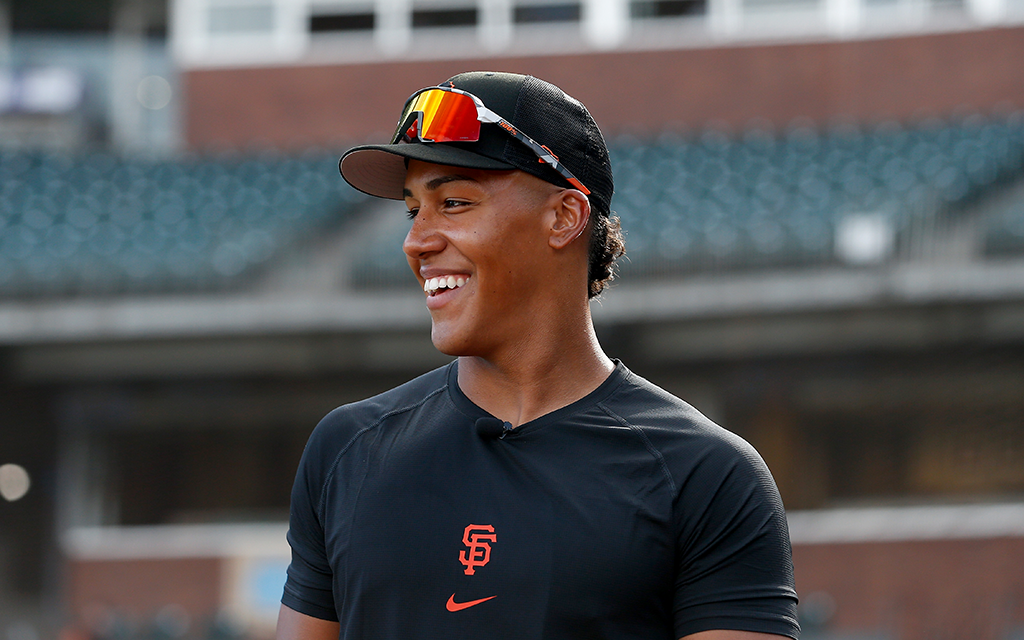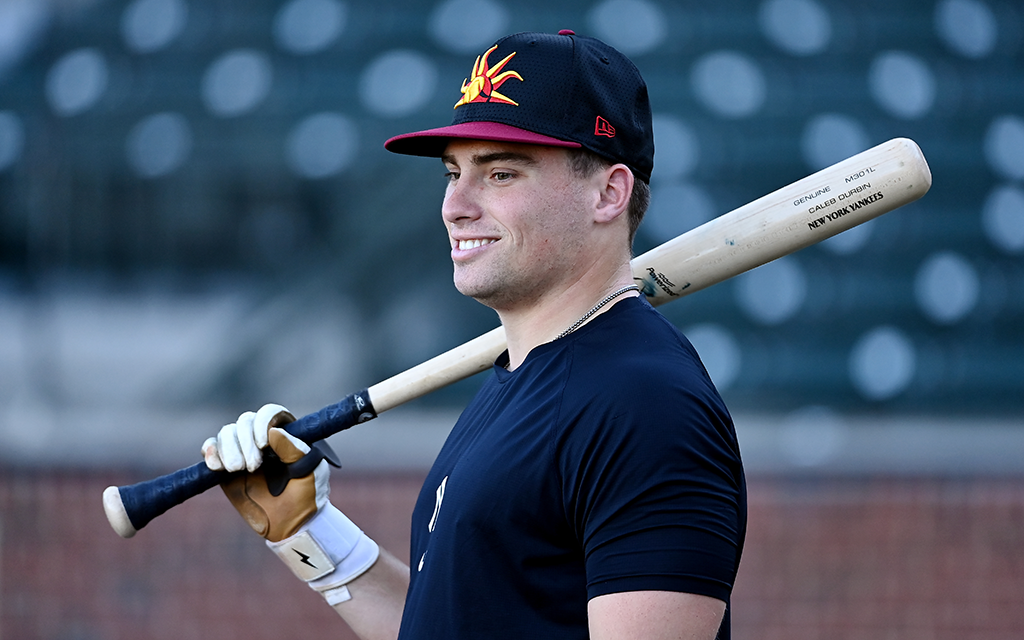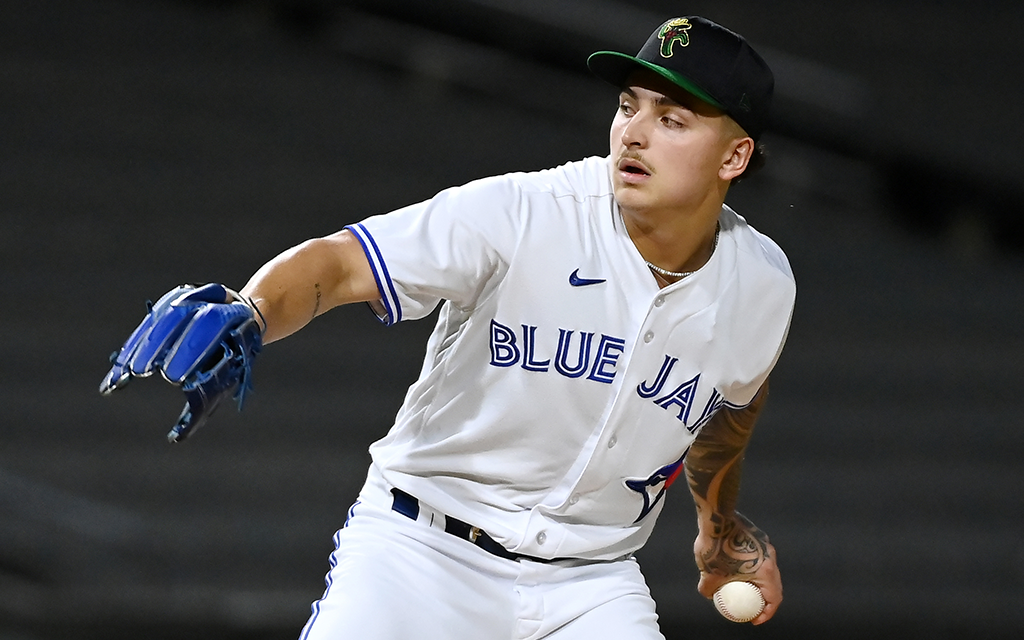
Reggie Crawford, a 2022 first-round pick for the San Francisco Giants, highlights the invaluable opportunity gained by facing top-notch competition in summer and fall baseball. (Photo by Lachlan Cunningham/Getty Images)
PHOENIX – Baseball didn’t end with the World Series. Baseball never ends. Like the ball itself, the sport rolls from one spot to the next, with the players who aim to make it at the highest level bouncing from collegiate competition to a crowd of summer leagues, or from stretches in the minors to the prestigious Arizona Fall League.
In some cases, athletes are up at the crack of dawn for first pitch. In others, they play as long as there is light (and mosquito repellent), which can vary depending on whether the games are in Georgia or the Great Lakes.
The Arizona Fall League is a whole different phenomenon. Ostensibly taking place during baseball’s “offseason,” the AFL runs through early October until Saturday, when a championship from the league’s six teams will be crowned. (A crack in the universe saw the 2023 AFL season coincide with the Arizona Diamondbacks’ pennant run and World Series bid, turning the Valley into a baseball buffet for a few weeks.)
Designed for top prospects in MLB’s farm system, the Fall League is an opportunity to prove one’s worth against high-level competition, while on the precipice of the major leagues. With scouts from all 30 MLB teams watching closely, the pressure can be difficult to handle. Fortunately for many players, a similar experience in college has helped guide their experience, and made the process less overwhelming.
At the collegiate baseball level, it is common for players to join teams in summer baseball leagues during the offseason. The leagues stretch across the country from the storied program on Cape Cod with its stunning beaches as a backdrop, to Alaska, where baseball is sometimes played at midnight under the summer glow.
While providing a temporary home to some of the country’s best young talent, these leagues present an opportunity to develop skills and garner professional attention. For decades, prospects have transformed their careers during this crucial development stage.
“If you were to look back at the players in the big leagues right now, they touched one of our 12 college summer leagues at some point,” said Arizona Fall League director Chuck Fox.
For more than 30 years, Fox and others in MLB have been involved in helping finance 12 collegiate summer baseball leagues, which are all part of the National Alliance of College Summer Baseball (NACSB). A non-profit organization, NACSB’s mission is simply to give young baseball players a chance to showcase their skills.
“It really is an opportunity for all of them to step up their game or realize where they need to grow and improve,” said Sean McGraf, commissioner of the New England Collegiate Baseball League. “They’re free of academic demands, and they’re having the opportunity to compete at very high levels six nights a week.”
In summer ball, prospects play a schedule that mirrors the minor leagues, unlike the collegiate schedule that consists primarily of weekend games. Like professionals, they can focus all of their energy on baseball. While doing so, however, they must adapt to a new environment away from home, becoming ingrained in their summer ball communities. It is a tremendous learning experience, and a great precursor of what’s to come.
“To pick up, move to a foreign territory, get settled in with a new team, with a new coach, with wood bats, while also adding the element of living with host families in a region away from home, it’s a lot of change,” McGraf said. “It’s a lot of moving parts.”
Reggie Crawford, a 2022 first-round pick of the San Francisco Giants, is currently playing in the Arizona Fall League with the Scottsdale Scorpions. In 2021, the UConn product was a member of the Bourne Braves in the Cape Cod League. His time in Massachusetts got him ready for the jump to pro ball the following year.
“That’s essentially the top competition you’re going to play at that level,” Crawford said. “And as long as you have that, that’ll give you the best preparation for facing what would then be the next step up.”
His experience in the Fall League strongly resembles his time in the Cape.
“I would say it’s a similar vibe,” Crawford said. “You’re playing a lot. You’re playing quality baseball players, and there’s in a sense that grind aspect to it to where everything isn’t put on a platter. But you find ways to scratch and claw, and get it done.”
Arriving in Arizona to play against the top prospects in MLB models the summer collegiate baseball experience. In college, players depart from their university programs to join a summer ball team of talented players from across the country, after finishing a grueling spring season. In the minor leagues, prospects finish up their season with an MLB affiliate, and soon after head to Arizona for another eight weeks of high-level baseball. The similarities are striking, and it makes those who have played summer ball more prepared for the stress of the Fall League.
“When they get to the Arizona Fall League, they’re quickly adapting to a new roster of elite players that they’ve seen in magazines,” McGraf said. “And it’s not all that different from summer ball. When they arrive everybody is looking at everybody’s resume, what school they go to.
“It does take skill and experience to learn, ‘Yeah I fit, I belong.’ By having had that experience in summer collegiate baseball, some of these players might have an easier time adjusting to an environment surrounded by All-Stars.”

Caleb Durbin’s successful run with the New York Yankees in the Arizona Fall League is attributed to playing at Washington University-St. Louis and in summer baseball. (Photo by Norm Hall/MLB Photos via Getty Images)
While summer baseball gives many a taste of the larger spotlight, for others, it represents an opportunity to get their first attention at all from professional scouts. Caleb Durbin was a star in college, hitting .385 his junior year. However, being at Division III Washington University-St. Louis, it was difficult to receive attention from MLB organizations. In the summers of 2019 and 2020, Durbin played for Fort Lauderdale in the South Florida Collegiate Baseball League (SFCBL), and it transformed his career.
“It was big-time,” Durbin said. “For me personally, I played more wood-bat games in the summer than I even did in spring ball for my college. And obviously, it translates more with good competition and physically using a wooden bat. I think that’s one of the biggest things that not only got me looks to be able to play pro ball, but helped me transition into pro ball.”
Durbin hit .310 with 29 stolen bases and a .413 on-base percentage for Fort Lauderdale in 2020. The Atlanta Braves drafted Durbin in the 14th round of the 2021 MLB Draft, and after being traded to the New York Yankees in 2022, he has thrived.
After reaching Double-A in 2023, Durbin’s tremendous performance in Arizona earned him a bid to the Arizona Fall Stars Game last Sunday. The opportunity for lower-level collegiate players to showcase their skills is something that Durbin hopes people understand about summer baseball.
“For a lot of guys, it is really important for them to play that level of competition and get those looks,” Durbin said. “I always took it super seriously, and I know a lot of my teammates took it super seriously.”
McGraf fondly remembers another Div. III player who got his break in the NECBL. Matt Koperniak, a four-year player at Trinity College, hit .376 for the North Adams SteepleCats of the NECBL in 2019. He signed with the St. Louis Cardinals as an undrafted free agent in 2020, and has quickly risen up the ranks, reaching Triple-A in 2022 and 2023.
“Without his journey through the NECBL, I don’t think he would have been as well-known when it came time for the draft,” McGraf said. “I know for a fact that his play and performance and his metrics quite frankly were a factor in him being selected as a free agent. The Cardinals believed in that, and his track record so far has proved them right.”
Durbin and Koperniak represent the growth of smaller summer baseball leagues in recent years. The Cape Cod League has long had a reputation for developing the best talent, but Fox is seeing more and more players come out of other areas.
“When you break down where are these guys from, it’s not just the Cape League,” Fox said. “You’re starting to see more of these leagues across the country produce the best players. That’s the exciting thing.”
Fox worked for nine years overseeing the MLB Draft, and saw how a prospect’s fortunes would be boosted dramatically if they had a strong summer ball performance on their resume. Success in summer ball will often translate to minor league baseball, and in particular, to the Arizona Fall League, where scouts are always watching.
“It helps them handle the pressure,” Fox said. “They’re here for a reason. They’re being evaluated and there are going to be scouts in the stand every night. This may be the most pressure they’re going to face. An organization is going to be a lot more comfortable writing the big check, knowing that the player has had success in good leagues like that.”
As the Fall League season comes to a close on Saturday, players will receive a well-deserved break. Crawford is cherishing the final moments of this special experience, as he did in summer ball.
“We’re lucky enough to be surrounded by such incredible baseball players,” Crawford said. There are different little things that work for everybody, and just having conversations, digging into certain things that may not be surface level, you’re able to maybe hear a cue or a thought that clicks for you that really locks in lessons for the future.”

